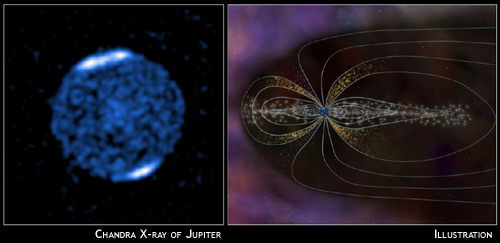Jupiter: The fifth planet from the Sun, as seen at a distance of about 400 million miles.
Caption: Chandra's X-ray image (left) shows bright polar caps associated with auroral activity on Jupiter. X-ray spectra revealed that this activity is caused by highly charged ions of oxygen and other elements crashing into the atmosphere above Jupiter's poles. The accompanying schematic illustrates how Jupiter's unusually frequent and spectacular auroral activity is produced. Particles (white dots) from Jupiter’s volcanically active moon, Io, drift outward to create a huge reservoir of electrons and ions that are trapped in the magnetic field (light blue lines). Strong electric fields created by Jupiter’s rapid rotation accelerate the trapped particles down into the atmosphere above the polar regions where they produce almost continual auroras. The swept-back structure of the magnetic field is caused by gusts of particles from the Sun, which can also trigger auroras.
Scale: X-ray image is 1.3 arcmin per side.
Chandra X-ray Observatory ACIS
Image
|


